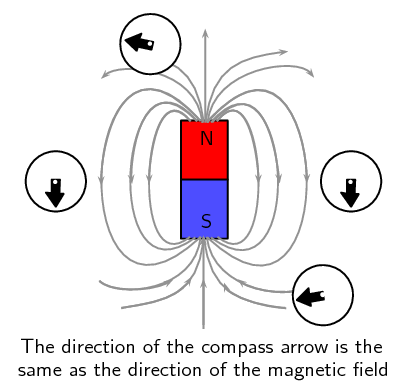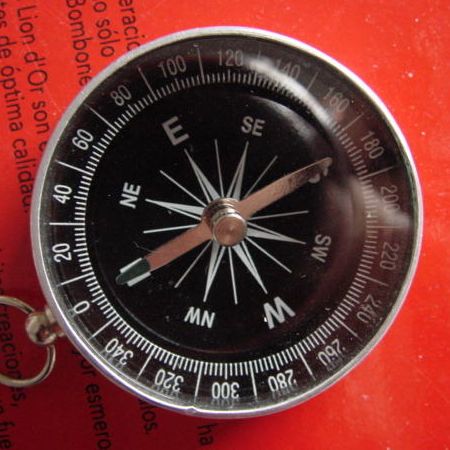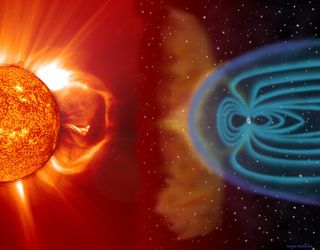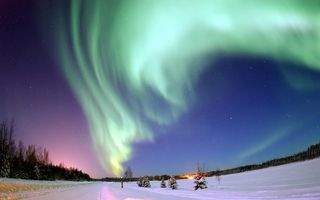15.4 The compass
|
Previous
15.3 Permanent magnets
|
Next
Chapter summary
|
15.4 The compass (ESAEN)
A compass is an instrument which is used to find the direction of a magnetic field. A compass consists of a small metal needle which is magnetised itself and which is free to turn in any direction. Therefore, when in the presence of a magnetic field, the needle is able to line up in the same direction as the field.


Lodestone, a magnetised form of iron-oxide, was found to orientate itself in a north-south direction if left free to rotate by suspension on a string or on a float in water. Lodestone was therefore used as an early navigational compass.
Compasses are mainly used in navigation to find direction on the earth. This works because the Earth itself has a magnetic field which is similar to that of a bar magnet (see the picture below). The compass needle aligns with the Earth's magnetic field direction and points north-south. Once you know where north is, you can figure out any other direction. A photograph of a compass is shown on the right.
Some animals can detect magnetic fields, which helps them orientate themselves and navigate. Animals which can do this include pigeons, bees, Monarch butterflies, sea turtles and certain fish.
A compass

Photograph by Alex on Flickr
The Earth's magnetic field (ESAEO)
In the picture below, you can see a representation of the Earth's magnetic field which is very similar to the magnetic field of a giant bar magnet like the one on the right of the picture. The Earth has two magnetic poles, a north and a south pole just like a bar magnet.
In addition to the magnetic poles the Earth also has two geographic poles. The two geographic poles are the points on the Earth's surface where the line of the Earth's axis of rotation meets the surface. To visualise this you could take any round fruit (lemon, orange etc.) and stick a pencil through the middle so it comes out the other side. Turn the pencil, the pencil is the axis of rotation and the geographic poles are where the pencil enters and exits the fruit. We call the geographic north pole true north.
The Earth's magnetic field has been measured very precisely and scientists have found that the magnetic poles do not correspond exactly to the geographic poles.
So the Earth has two north poles and two south poles: geographic poles and magnetic poles.

The direction of the Earth's magnetic field flips direction about once every \(\text{200 000}\) years! You can picture this as a bar magnet whose north and south pole periodically switch sides. The reason for this is still not fully understood.
The Earth's magnetic field is thought to be caused by flowing liquid metals in the outer core of the planet which causes electric currents and a magnetic field. From the picture you can see that the direction of magnetic north and true north are not identical. The geographic north pole is about \(\text{11,5}\)\(\text{°}\) away from the direction of the magnetic north pole (which is where a compass will point). However, the magnetic poles shift slightly all the time.
Another interesting thing to note is that if we think of the Earth as a big bar magnet, and we know that magnetic field lines always point from north to south, then the compass tells us that what we call the magnetic north pole is actually the south pole of the bar magnet!
Phenomena related to the Earth's magnetic field (ESAEP)
The importance of the magnetic field to life on Earth
The Earth's magnetic field is very important for humans and other animals on Earth because it protects us from being bombarded (hit) by high energy charged particles which are emitted by the Sun. The stream of charged particles (mainly positively charged protons and negatively charged electrons) coming from the sun is called the solar wind. When these particles come close to the Earth, they are deflected by the Earth's magnetic field and cannot shower down to the surface where they can harm living organisms. Astronauts in space are at risk of being irradiated by the solar wind because they are outside the zones where the charged particles are trapped.
Visualisation of the magnetosphere

The region above Earth's atmosphere in which charged particles are affected the Earth's magnetic field is called the magnetosphere. Relatively often, in addition to the usual solar wind, the Sun may eject a large bubble of material (protons and electrons) with its own magnetic field from its outer atmosphere. Sometimes these bubbles travel towards the Earth where their magnetic fields can join with Earth's magnetic field. When this happens a huge amount of energy is released into the Earth's magnetosphere, causing a geomagnetic storm. These storms cause rapid changes in the Earth's magnetosphere which in turn may affect electric and magnetic systems on the Earth such as power grids, cellphone networks, and other electronic systems.
Aurorae (pronounced Or-roar-ee)
Another effect caused by the Earth's magnetic field is the spectacular Northern and Southern Lights, which are also called the Aurora Borealis and the Aurora Australis respectively.
When charged particles from the solar wind reach the Earth's magnetosphere, they spiral along the magnetic field lines towards the North and South poles. If they collide with particles in the Earth's atmosphere, they can cause red or green lights which stretch across a large part of the sky and which is called the aurora.
Aurora borealis photographed in Alaska

Aurora australis photographed from space

As this only happens close to the North and South poles, we cannot see the aurorae from South Africa. However, people living in the high Northern latitudes in Canada, Sweden, and Finland, for example, often see the Northern lights.
|
Previous
15.3 Permanent magnets
|
Table of Contents |
Next
Chapter summary
|
